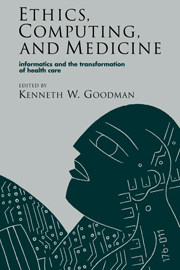Book contents
- Frontmatter
- Contents
- Preface
- List of contributors
- 1 Bioethics and health informatics: an introduction
- 2 Medical informatics and human values
- 3 Responsibility for computer-based decisions in health care
- 4 Evaluating medical information systems: social contexts and ethical challenges
- 5 Health care information: access, confidentiality, and good practice
- 6 Ethical challenges in the use of decision-support software in clinical practice
- 7 Outcomes, futility, and health policy research
- 8 Meta-analysis: conceptual, ethical, and policy issues
- Index
3 - Responsibility for computer-based decisions in health care
Published online by Cambridge University Press: 12 November 2009
- Frontmatter
- Contents
- Preface
- List of contributors
- 1 Bioethics and health informatics: an introduction
- 2 Medical informatics and human values
- 3 Responsibility for computer-based decisions in health care
- 4 Evaluating medical information systems: social contexts and ethical challenges
- 5 Health care information: access, confidentiality, and good practice
- 6 Ethical challenges in the use of decision-support software in clinical practice
- 7 Outcomes, futility, and health policy research
- 8 Meta-analysis: conceptual, ethical, and policy issues
- Index
Summary
When errors are made or things go wrong or decisions are beguiled, there is a very powerful and common human inclination to assess and apportion responsibility: Who's to blame? Whether any particular act of commission or omission is morally blameworthy is determined against a broad background of shared values and in the context of more or less deep understandings of causation and responsibility. In this chapter, Professor John W. Snapper develops his distinctive model for evaluating responsibility for computer-based medical decisions. In this model, the computer emerges as an agent that can be deemed responsible for certain kinds of errors. With the goal of promoting appropriate computer use by clinicians, Professor Snapper's distinctive analysis avoids conundrums about causes of harms, and eschews puzzles that often arise in attempting to identify foreseeable risks. Rather, it presents an argument for spreading responsibility and diversifying duty. Professor Snapper argues that appropriately attributing responsibility and duty to computers for certain actions will maximize the social goods that would follow from broader use of machines for decision support. What is increasingly clear is that legal approaches to error and liability in medical computing are inadequate in the absence of thoroughgoing conceptual and ethical analyses of responsibility, accountability, and blame.
Mechanical judgments and intelligent machines
Modern medical practice makes use of a variety of “intelligent machines” that evaluate patient conditions, help in literature searches, interpret laboratory data, monitor patients, and much more.
- Type
- Chapter
- Information
- Ethics, Computing, and MedicineInformatics and the Transformation of Health Care, pp. 43 - 56Publisher: Cambridge University PressPrint publication year: 1997
- 3
- Cited by



